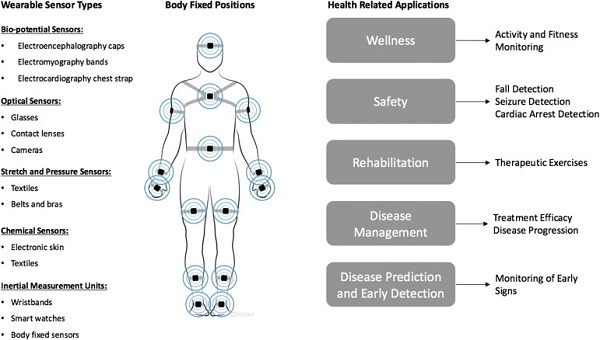Everything You Need to Know About the Wearable Sensors and Their Uses
The computing device or technology that comes integrated with textiles and clothing can be termed as wearable electronics. When integrated with wearable technology, the textiles can help in the communication process, computing the physical senses, memory, and much more. Every technology that can be worn on the body comes under the category of wearable electronics. Wearable technologies can be attached to the body in different ways. They can be attached to shirts, jackets, tees, or other wearable accessories like caps, glasses, or even on the bare hands. Wearable technology requires sensors for computing human behavior. With the evolving technology of the sensors, wearable electronics can now function more precisely than ever. They can provide accurate information about variations in your lifestyle.

In this article, we have mentioned some of the best sensors used in wearable technologies for a very long time. These sensors have improved a lot over time, and they are now providing even more promising results.
- Accelerometer
Accelerometers are one of the most extensively used sensors in wearable electronics. They can measure the data for different purposes. Accelerometers can measure acceleration forces that may be static as well as dynamic. They can track the sleep patterns and track the speed and acceleration of a user who is using it for running purposes.
- Gyroscope
Gyroscopes are the most commonly used sensors in wearable electronics. These sensors are a bit different from accelerometers as they only keep track of the angular accelerations. They use Earth’s gravity to help determine the orientation. These sensors maintain the level of effectiveness by providing precise information on the data that gets tracked.
- Magnetometers
These sensors can be integrated with gyroscopes and accelerometers to create an inertial measurement unit. Magnetometers can measure the relative change in the magnetic field and the strength and direction of the magnetic field at a particular location.
- Global Positioning Systems (GPS)
GPS is one of the most extensively used among the list of sensors. It is used in many devices like smartwatches and smartphones. With the help of GPS, users can search for any particular location which they want. When a user tries to search for an appropriate location, the information is sent to the satellite to check for the input by the user. After quantifying the exact location, accurate information is sent to the user.
- Heart Rate Sensors
There are various types of sensors available for heart rate monitoring. Heart rate sensors use a technique like Photoplethysmography, which uses light to track the blood flow volume charges; the Captive Sensing technique is based on the captive coupling that can easily detect and measure heart rates. Various fitness trackers rely on these techniques using a photodiode. A continuous green light that is transmitted into the wearer’s skin measures the light absorption by a photodiode, which is transferred to calculate the pulse. More diodes will get absorbed in case there is an increase in blood flow in the bloodstream of the user.
- Pedometers
These sensors are found mainly in the wearables, which are focused on physical health. They can count the steps of the users while he is running, jogging, or simply walking. Pedometers can be found in two variants electrical and mechanical. The electrical pedometers are more popular than the mechanical pedometer; however, they also use the mechanical pedometer principles to operate.
- Pressure Sensors
These sensors are operated with the help of strain gauges. They are used to measure the mechanical quantities like force. This force is measured by the construction of a Wheatstone Bridge, which tracks the dynamic and static changes in the resistance when the pressure is applied to the sensors.
Source:- https://good-antivirus.com/everything-you-need-to-know-about-the-wearable-sensors-and-their-uses/